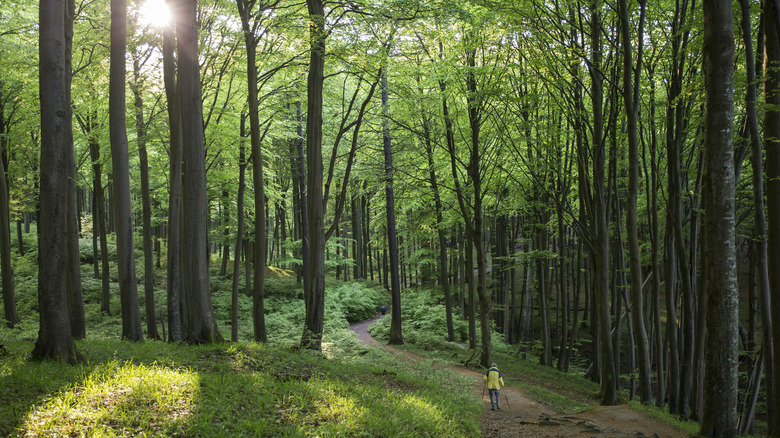Germany's Smallest National Park Is An Underrated Coastal Gem With Gorgeous Cliff Hikes
Germany is the land of the Black Forest, Oktoberfest, castles on the Rhine, a tumultuous history, and mysterious fairy tales. Scattered throughout this historical country, you'll find a surprising amount of natural, scenic beauty. Actually, Germany is a perfect getaway for nature lovers, with 16 national parks that preserve old forests, winding rivers, mountain peaks, and seaside vistas.
The smallest of these national parks lies on the largest German island, Rügen Island, off the coast of the Baltic Sea. The dazzling white cliffs of Jasmund National Park fringe the ancient beech forests of the island and provide excellent views of the Baltic. Jasmund National Park — a UNESCO World Heritage Site — is only 12 square miles, but every inch is worth exploring, from the silvery trunks of the old beeches to the 383 feet-high white cliffs jutting into aquamarine waters that seem to belong in the Caribbean rather than Germany.
Hiking through forest and on cliffs in Jasmund National Park
The best way to explore one of Europe's most spectacular national parks is by foot on one of its many trails. Although the white cliffs of Jasmund attract most visitors, the incredible 700-year-old beech forests are also a must-see. Europe was once covered in these beech forests, but only a few pockets remain. Jasmund's forests are particularly notable, as they're considered nearly pristine and untouched by human hands.
Multiple trails lead through the forest to the coast, from easy, short walks that take under two hours to longer, harder treks covering over 11 miles. The most accessible hike and the best introduction to the park begins at the Hagen carpark and ends at Königsstuhl, or King's Chair, the most famous of the white chalk cliffs. This trail cuts through the ancient forest to the white cliffs, providing ample opportunity to see the park's flora and fauna, like protected orchids and white-tailed eagles.
Tips for exploring Jasmund National Park
Although it's comparatively tiny in relation to other German national parks, 1 million visitors travel to Rügen Island for Jasmund National Park each year. See the main highlight — the famous Königsstuhl cliffs — at the Königsstuhl National Park Centre or from the Victoriasicht viewpoint. The park center has a new Skywalk Königsstuhl offering panoramic views of the Baltic and the cliffs, as well as educational exhibits, playgrounds, and a small café.
The best way to visit Jasmund is by train or, ideally, by car so that you can explore the entirety of the park. Just know the park is a hiking area, so you can only park on the edges in designated lots or take a shuttle bus to the park center. There's also a newer (from 2019) gravel biking path through the park if you wish to cycle.
The best time of year to visit Germany and Jasmund National Park depends on your preferences. The park is gorgeous — but busy — under the summer sun. If you're willing to brave chilly weather in the winter, you'll find spectacular foggy forests and picturesque, quiet beaches. The fall colors of the forest are stunning against the white cliffs, although it's admittedly windy. Springtime is also an excellent time to explore the shores with smaller crowds and (hopefully) better weather.


